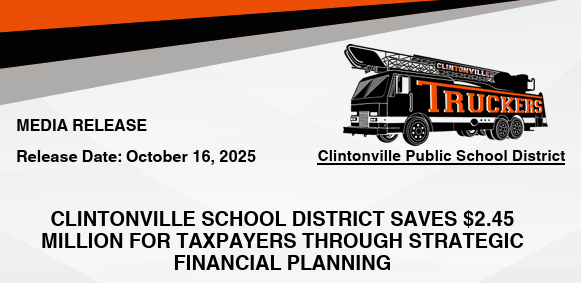Clintonville School District Saves $2.45 Million for Taxpayers Through Strategic Financial Planning
(Clintonville, WI.) The Clintonville School District continues to demonstrate strong fiscal stewardship, saving local taxpayers more than $2.45 million in future financing costs through strategic financial planning and early debt repayment. These efforts are part of a multi-year plan to strengthen the district’s long-term financial stability, manage tax rates responsibly, and protect educational investments for students.
Turning Deficits into Stability
Three years ago, the Clintonville School District partnered with CESA 8’s Financial Services team, led by Nick Curran, Director of Business Services, and Jessica Holtz, Director of Finance, to review and strengthen the district’s financial practices. In just one year, the district transformed a multi-million-dollar deficit into a $600,000 surplus, a turnaround achieved by prioritizing essential needs over wants and taking a deeper look at Wisconsin’s complex school funding system.
“In addition to focusing on the operational budget, we also examined our community service fund,” said Superintendent Troy Kuhn. “Funds had been set aside for major renovation projects at the Clintonville Recreation Center and Dellwood Childcare Center. By completing those projects on or under budget, we were able to redirect unused funds to benefit taxpayers.”
The Recreation Center received necessary boiler and pool system upgrades, while the Dellwood Childcare Center saw targeted improvements, including new electrical systems, a kitchenette, and a turf-based playground without the need for costly new construction.
A Strategic Approach to Debt Repayment
Working closely with the Clintonville Board of Education, Kuhn and Curran proposed a financial strategy that uses existing community service fund balances to cover ongoing expenses, avoiding the need for additional community service taxes. Instead, those tax dollars were reallocated toward early repayment of district construction debt tied to the $37 million referendum that funded the new middle school, elementary renovations, and other critical facility upgrades.
“At last year’s Annual Meeting, the Board supported this approach,” explained Curran. “By applying prior-year community service funds to current expenses, we could dedicate more tax dollars to paying down long-term debt early without increasing the total tax rate.”
This approach, known as a debt defeasance, is similar to paying off a mortgage ahead of schedule. By paying down debt sooner, the district will save taxpayers $2.45 million in future interest costs this year and an additional $1.79 million next year, while also qualifying for increased state aid.
“The spending within the community service fund doesn’t receive state reimbursement,” Curran said. “But debt payments do. Redirecting those dollars increased our eligibility for state aid, all while keeping the mill rate steady.”
Building Understanding and Transparency
Both Kuhn and Curran emphasized that financial education and transparency have been key parts of the process.
“We’ve spent time helping the Board and community understand the difference between the mill rate and total tax impact,” Kuhn said. “Even when the mill rate stays the same, reassessments and rising property values can make taxes feel higher. That distinction wasn’t always clear during past referendums, so improving communication has been a top priority.”
School Board Treasurer Jason Moder agreed, noting that property values in some areas have increased by 10%–30%.
“This strategy helps us manage those changes responsibly,” said Moder. “We’re working to keep total taxes stable or even slightly lower, despite inflation and rising costs.”
Kuhn added, “Even though expenses have increased, we remain committed to valuing taxpayers and protecting their investment in our schools. If we can hold or lower the mill rate while maintaining quality educational programs, that’s a win for everyone.”
Reinvesting Savings, Not Stockpiling Funds
While the financial results are positive, district leaders are careful to clarify that the savings do not mean Clintonville has surplus funds.
These savings are being reinvested to strengthen the district’s long-term stability and protect educational programs, not because the district has extra money, but because we’re making existing dollars work smarter for taxpayers and students,” said Kuhn.
This disciplined approach helps the district prepare for future needs, including facility maintenance and operational challenges, without increasing local tax burdens.
Looking Ahead
The 2025–26 financial plan includes an additional debt defeasance of more than $6 million, expected to save taxpayers another $1.79 million in interest while maintaining strong state aid levels and steady educational spending.
“This approach sets the district up for long-term success,” said Curran. “By continuing to pay down debt early and maximize aid, we’re creating a foundation that supports future operational and facility needs.”
Kuhn added, “If the stars continue to align, this positions us well for a future operational referendum. We can continue to pay down debt faster, maintain stable taxes, and direct more resources toward student success. That’s the kind of financial planning every community hopes for.”
The Clintonville School Board will review and finalize its next phase of financial recommendations at the Annual Meeting at 6:00 p.m. on October 27, 2025, in the Clintonville High School IMC. Community members are encouraged to attend to learn more about the district’s financial strategies and how they impact both taxpayers and students.

